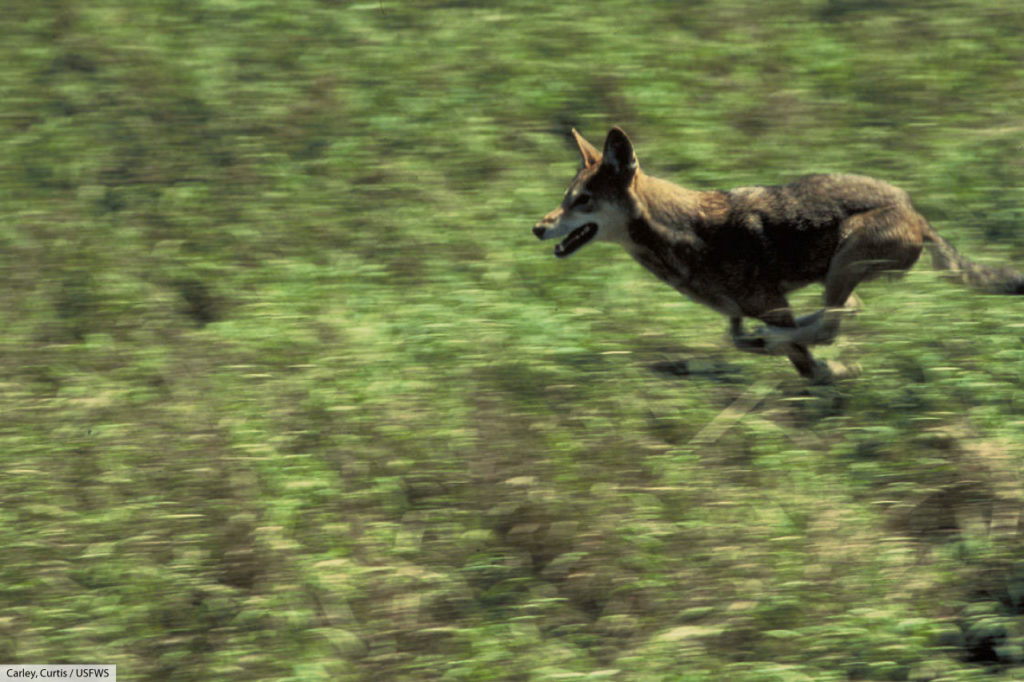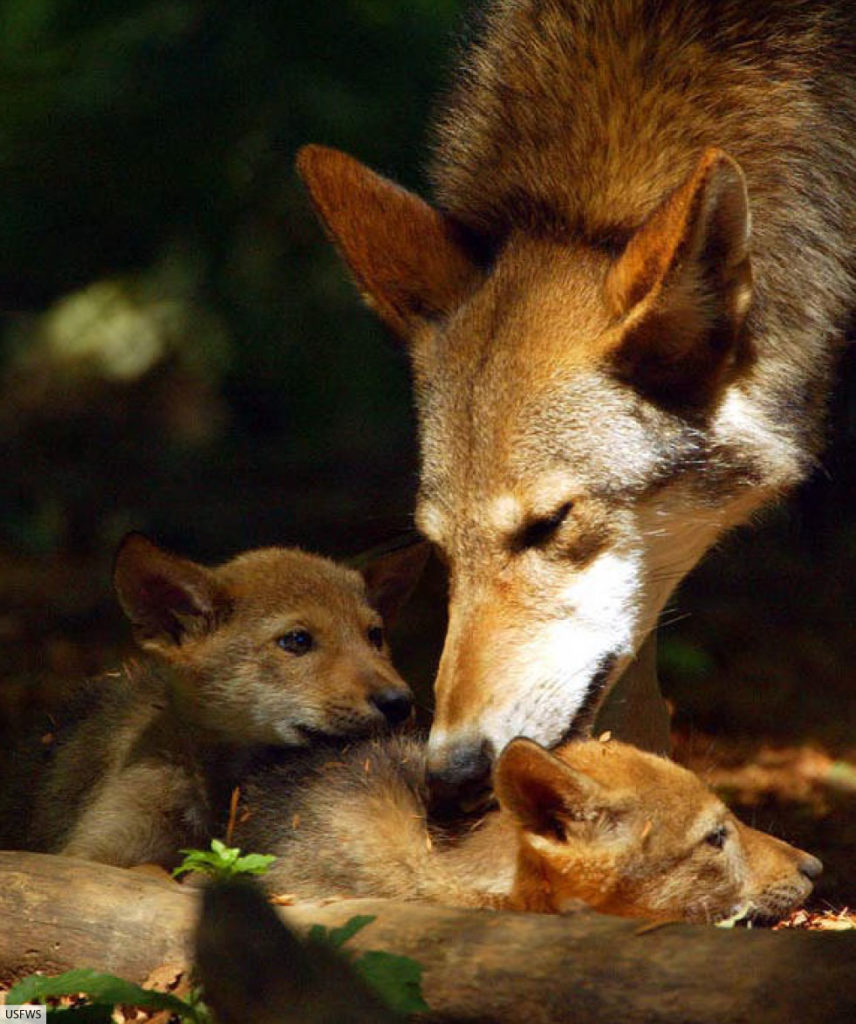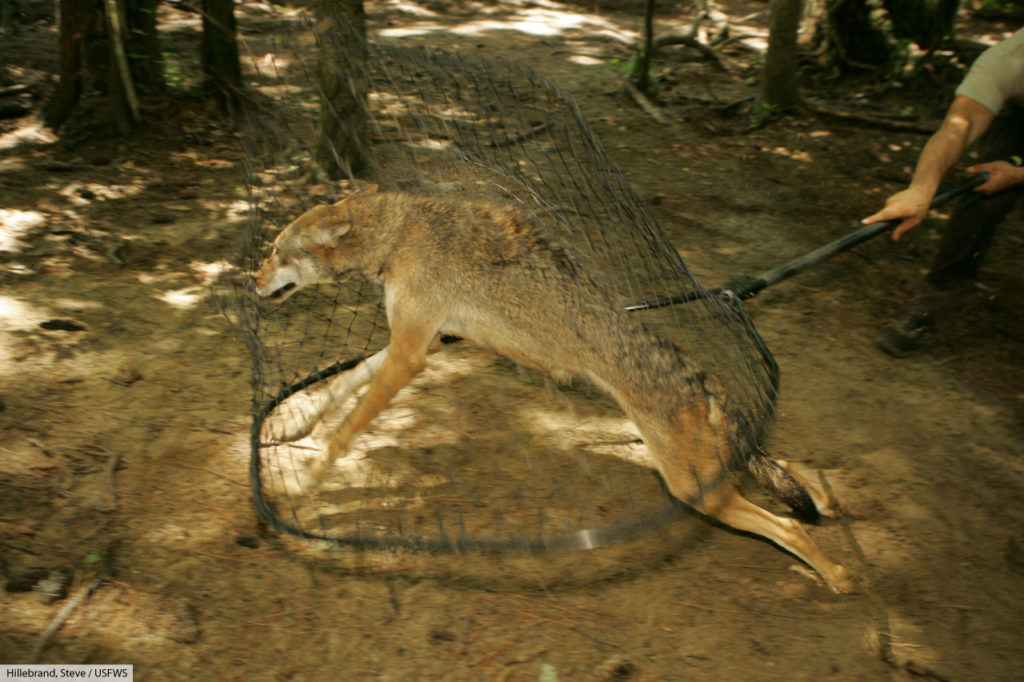The red wolf is a critically endangered North American mammal. Midway in size between a grey wolf and a coyote, the species gets its name from the characteristic red tinge of its coat.
In 1980 the red wolf was declared to be extinct in the wild. A re-introduction program was established in North Carolina. Although initially successful, the re-introduced population is now struggling; today only around 40 red wolves exist in the wild.
There is much argument over whether or not the red wolf is actually a separate species rather than either a grey wolf / coyote hybrid or a subspecies of grey wolf.
Let’s find out more about this beautiful – and controversial – animal.

Red Wolf Facts At A Glance
- Other Name(s): Florida black wolf, Mississippi Valley wolf
- Scientific name: Canis rufus
- Type of Animal: Mammal, Carnivoran
- Animal Family: Canidae (the dog family)
- Where Found: North America
- Length (nose to tail):22 m (4 ft.)
- Height: 66 cm (26 in)
- Weight: 20 to 36 kg (45 to 80 lb.)
- Conservation Status: Critically Endangered
Red Wolf Video
You can see awesome close-up footage of these beautiful animals in the video below:
Meet The Red Wolf: Introduction
When is a species not a species?
The red wolf has its own scientific name (Canis rufus) and is considered by some to be the United States’ third canid (dog) species, alongside the grey wolf and the coyote.
However, the red wolf’s status as a distinct species is controversial. Many scientists consider the red wolf to be either a grey wolf / coyote hybrid, or a subspecies of grey wolf.
(A hybrid is the offspring between two different, but very closely related species, such as a wolf and a coyote, or a horse and a donkey).
Another theory suggests that the red wolf is in fact an eastern wolf, another disputed species. (The eastern wolf is usually considered to be a grey wolf subspecies.)
The red wolf is listed as a subspecies of grey wolf in the Catalogue of Life, a global database of species. The red wolf is also listed as being a subspecies of grey wolf in Mammal Species of the World, a respected reference work.
Although the IUCN currently lists the red wolf as a separate species, it notes that the classification is provisional.

How To Recognize A Red Wolf
The red wolf gets its name from the cinnamon / red-grey color of its neck, flanks and legs. It is midway between the grey wolf and the coyote in size, weighing from 20 to 36 kg (45 to 80 lb.) There is some overlap in the size of large red wolves and small grey wolves.
The ruff of the red wolf is less prominent than that of other wolves, and the ears proportionally longer. The legs are long and slender, giving the red wolf a slightly ‘greyhound-like’ appearance.

Where Is The Red Wolf Found?
In the past, the red wolf was found in the southeastern United States, from southern Florida westward to Central Texas. The species’ historical range may have extended as far northwards as Pennsylvania and even to southern Canada.
Today the red wolf is only found on the on the Albemarle-Pamlico Peninsula in eastern North Carolina. The 40 or so wolves found in this area represent all that remains of re-introduction efforts begun in the 1980’s. (See the Red Wolf Reintroductions section, below)
Red Wolf Habitat
The historical range of the red wolf includes many different types of habitat. The species is most commonly associated with the forests, swamps and coastal prairie marshes of the southeastern United States.
Unlike coyotes, wolves do not tolerate the presence of humans. Coyotes may be seen near, or even in, suburban areas. By contrast wolves are strictly animals of the wilderness.
In order to sustain a wolf population, a habitat must also be able to sustain an adequate amount of suitable prey.
Red Wolf Behavior

The red wolf is a pack animal, but is not as social as the grey wolf. It lives in family groups that consists of an alpha pair and from 3 to 6 of their young.
The red wolf is most active at dusk and dawn
Red Wolf Diet
The red wolf’s diet consists mainly of small to mid-size mammals such as rabbits, rodents and deer.
The wolf adjusts its hunting style according to the size of its prey. Small animals are pounced on. Mid-sized species may be suffocated with bites to the throat. Larger prey animals are overcome by wounds received from bites delivered during a chase.
Species targeted by the red wolf include white-tailed deer, raccoons and nutria. (Also known as the coypu, the nutria is a non-native species introduced from South America).
Red Wolf Family Life

Mating takes place in February, with the pups being born in April and May. Red wolves mate for life. Females give birth in well-hidden dens. These may be located in hollow tree trunks, spaces between rocks, holes in riverbanks or similar secure areas. An average litter consists of 6 to 7 young.
Bringing up the cubs is a family affair. Both parents take part in the rearing of the young. Mature offspring from earlier years who are still present in the family group may also assist in rearing their siblings.
The survival rate for red wolf pups is low, with under 50% reaching adulthood.
Red Wolf Reintroductions

The red wolf is one of the world’s most endangered animals, with only around 40 individuals left in the wild and a further 200 individuals living in captivity.
The wild red wolf population of today represents all that remains of a 1980’s re-introduction program.
In 1967 the decline of the wild red wolf population led to the species being listed as endangered in the U.S. under the Endangered Species Preservation Act. (The IUCN listed the red wolf as Critically Endangered in 1996.)
In order to protect the species, a captive breeding program was established by the U.S. Fish and Wildlife Service.
Of the 79 wolves taken from the wild as part of the program, only 14 were found to be ‘pure’ red wolves; the others were either grey wolves, coyotes, or grey wolf / coyote hybrids.
In 1977 the breeding program began to bear fruit, with a litter of red wolves being born in captivity. By 1988 the 14 captive red wolves had produced 80 young.
In 1980 the red wolf was declared extinct in the wild. The future of the species now lay with the breeding program.
In 1986 a colony comprising red wolves from the breeding program was established in the Alligator River National Wildlife Refuge in eastern North Carolina. In 1988 this ‘nonessential experimental population’, or NEP, produced its first litter.
A separate re-introduction program was begun in the Great Smoky Mountains National Park in 1992. Two breeding pairs were introduced and in the following year the population had produced a litter of pups.
However, over the following years the Smoky Mountains population struggled to sustain itself due to a shortage of potential prey. In 1998 the project was ended.
By 2006, the Alligator River population had reached its peak, numbering around 120 to 130 wolves. Sadly, since then the population has declined to around 40 animals in 2018.
The Importance Of Correct Classification
Studies carried out after the captive breeding program had begun found that even the 14 red wolves from which the entire re-introduced population was founded were genetically the same as Louisiana coyotes.
These findings suggest that the red wolf may have been bred out of existence before the 20th century; that’s if it had ever existed as a separate, non-hybrid species at all.
The red wolf’s uncertain classification status affects potential conservation efforts. Neither the grey wolf nor the coyote are themselves endangered (despite huge reductions in the grey wolf’s range in the U.S., its global population is relatively healthy).
If the red wolf is considered either to be a subspecies of grey wolf or a grey wolf / coyote hybrid, then its conservation is less likely to be given priority than if it were a separate species.
Why Is The Red Wolf Endangered?
The red wolf is endangered primarily due to habitat loss, hybridization with coyotes, disease, and historical persecution. Once common in the southeastern United States, extensive deforestation and development destroyed much of their natural habitat.
Hybridization with coyotes, which increased as wolf populations declined and habitats overlapped, further threatened the genetic purity of red wolves.
Diseases such as canine distemper and parvovirus also negatively impacted their populations. Moreover, extensive predator control programs and hunting in the past drastically reduced their numbers. These combined factors led to the red wolf's classification as critically endangered.
Red Wolf Threats
The biggest threat to the red wolf is hybridization with coyotes. Other threats include hunting and vehicle collisions.
Red Wolf Facts: Related Pages
- Find out more about the Eurasian Wolf
- Discover another remarkable North American canid: Coyote Facts
- You can see a list of every wild dog species here: Wild Dog Species With Pictures & Facts
- Find out more about mammals: Mammals: The Ultimate Guide
- Become an animal expert: Animals: A Complete Guide To The Animal Kingdom
- Discover amazing animals from all around the world: A to Z Animals
- See a collection of awesome animal books: Active Wild Natural History Bookstore



how are red wolfs endangered
Hi,
That’s a great question; we’ve now added a Why Is The Red Wolf Endangered? section to this page.
Regards,
The Active Wild Team
I have trail cam pictures of what I think is a red wolf in Randolph County, NC
Where can I send them for identification? I’m pretty familiar with coyotes and even some coydogs so I’m not goofing around
Hi Roger, thank you for your comment. The USFWS has a special Red Wolf Hotline and email address for reporting sightings and other red wolf enquiries.
Let us know the outcome!
Regards,
The Active Wild Team
Poor red wolves being captured